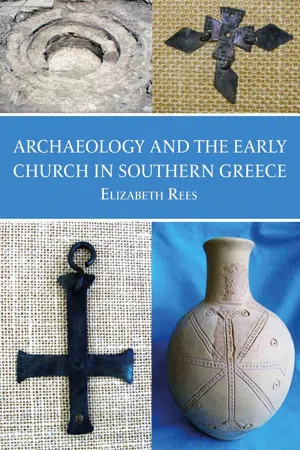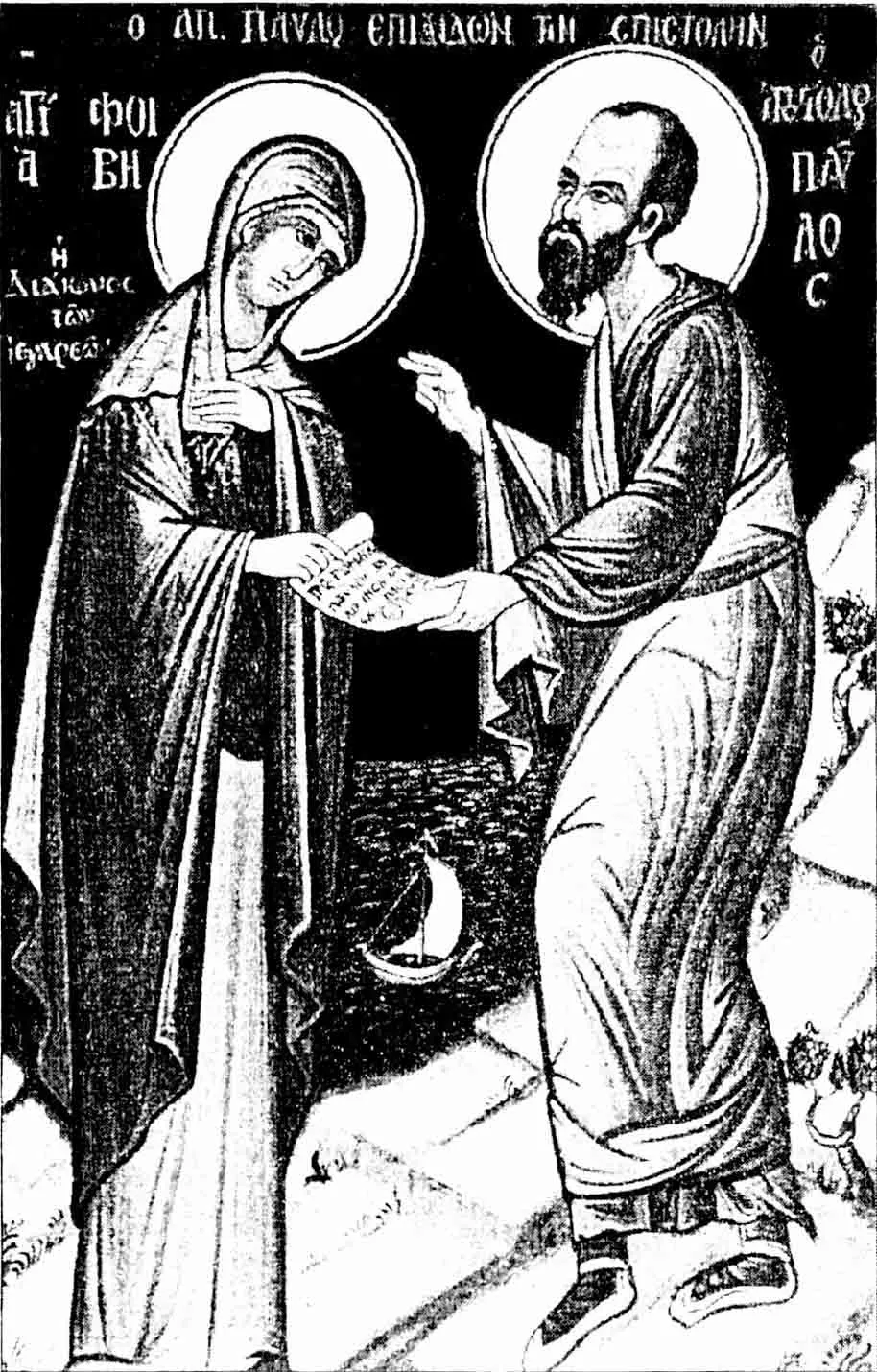![]()
Chapter 1
PHOEBE OF KENCHREAI: A GENEROUS WOMAN
W e shall begin this exploration of early Christian sites in southern Greece by focusing on first-century Kenchreai, the busy eastern port of ancient Corinth, where textual evidence from the mid-first century hints at the evolution of Christianity when it was still a relatively small sect, partly Jewish and partly gentile. Here, a woman named Phoebe was a leader in the early Christian community; she was also a close friend of St Paul. By exploring the language that he uses to describe Phoebe, we can learn more about this remarkable woman and her role in the Church. Later texts explain the meaning of the words that Paul chose to describe her ministry. These authors also shed light upon the unexpected role of women in the Church and in wider society at this time.
A series of excavations, largely around the seashore, tell us a considerable amount about life in first-century Kenchreai, much of which lies beneath the modern village of Kenchries. No evidence of early house churches has been discovered but, as we shall see, early texts suggest that Phoebe was moderately wealthy, and we can to some extent envisage her way of life. Early tombs re-used by Christians in the fourth century, and a sixth-century basilica at Kenchreai, now largely submerged, provide information about the life and worship of Christians in the port during succeeding centuries, when the region became thoroughly Christianised. These later sites will be examined in Chapter 2.
St Paul’s relationship with Phoebe is a fascinating one. He speaks of her at the end of his Letter to the Romans, which he wrote when he was living in Corinth, around AD 56/7:
I commend to you our sister, Phoebe, who is a deacon ( diákonon ) of the church at Kenchreai, in order that you might receive her in the Lord, as is appropriate to the saints. Help her in whatever she might need, for she has been a patron ( prostátis ) of many, including myself (Rom. 16. 1–2).1
A letter of introduction
Chapter 16 of Paul’s Letter to the Romans appears to be a letter of introduction which would enable Phoebe to be welcomed by another Christian community. It is often assumed that this was the community in Rome, but this may not be the case. Internal evidence suggests that Romans 16 may be a short letter written to a different group of Christians, apart from its final doxology, or closing words of praise to God. This doxology may constitute the last paragraph of the entire Letter to the Romans:
Glory to him who is able to give you the strength to live according to the Good News I preach … He alone is wisdom; give glory therefore to him through Jesus Christ for ever and ever. Amen (Rom. 16. 25–7).
The oldest surviving manuscript of Paul’s Letter to the Romans, a papyrus from the early third century, places the great doxology of Romans 16. 25–7 at the end of chapter 15; this suggests that some early Christians believed that Paul’s Letter to the Romans ended at this point. Of the later manuscripts, some place the doxology at the end of chapter 14; chapter 15 then becomes an epilogue. Most of the later texts place the doxology at the end of chapter 16, where we find it today.2
Scholars have reached differing conclusions about the origin of Romans 16, but this short letter of commendation may have been intended for Phoebe to take with her to the Christians in Ephesus (Fig. 2).3 It consists of a recommendation of Phoebe (vv. 1–2), followed by greetings to specific families and individuals (vv. 3–16). A short exhortation to stay faithful to the gospel follows (vv. 17–20), and the letter of introduction ends with some final greetings from Paul, from Gaius who was his Corinthian host, from a scribe named Tertius who wrote the letter, and from a few more of Paul’s friends in Corinth (vv. 21–3).
Paul’s words, ‘Greet my dear friend Epaenetus, who was the first convert to Christ in the province of Asia’ (v. 5) would make less sense in a Roman context than in an Asian one; such a reference would have little meaning in a letter to Roman Christians.4 If Phoebe was a businesswoman – a possibility that will be explored later in the chapter – she would be more likely to have traded with cities in Asia Minor, such as Ephesus, than with clients in Rome. Kenchreai was Corinth’s point of departure for Asia Minor; we would expect Phoebe to live in Lechaion, Corinth’s northern port, if she travelled to and from Rome. Perhaps Phoebe already knew the Christians of Ephesus before Paul entrusted her to them with his letter of commendation. It is important to remember, however, that many scholars find the traditional Roman destination of Phoebe’s journey to be equally convincing.5
FIGURE 2. Paul gives Phoebe her letter of introduction, before she departs from Kenchreai harbour. Drawing by a modern Greek monk.
Paul greets his friends
Paul identifies Phoebe as ‘our sister’ (Rom. 16. 1) to underline that as a disciple of Jesus, she is one of them. Mark recalls Jesus saying ‘Whoever does the will of God is my brother, and sister, and mother’ (Mk. 3. 35). Even if the Christians of Ephesus met her for the first time when she arrived with her letter of introduction, she was already their sister because she belonged to the Christian family.6
The first couple to be greeted are Priscilla and Aquila (vv. 3–5), who appear to have been living in Ephesus at this point, according to the author of the Acts of the Apostles:
After staying on [in Corinth] for some time, Paul took leave of the brothers and sailed for Syria [i.e. to Antioch], accompanied by Priscilla and Aquila. At Kenchreai he had his hair cut off, because of a vow he had made. When they reached Ephesus, he left them, but first went alone to the synagogue to debate with the Jews. They asked him to stay longer but he declined, though when he left he said, ‘I will come back another time, God willing’. Then he sailed from Ephesus (Acts 18. 18–21).
As we have seen, the next person that Paul names in his letter of commendation is Epaenetus (v. 5), the first person whom he converted at Ephesus. Then there are brief messages to other Christians in the church to which Phoebe is travelling:
Greetings to Mary who worked so hard for you; to those outstanding apostles, Andronicus and Junia, my compatriots and fellow prisoners who became Christians before me; to Ampliatus, my friend in the Lord; to Urban, my fellow worker in Christ; to my friend Stachys; to Apelles who has gone through so much for Christ; to everyone who belongs to the household of Aristobulus; to my compatriot Herodion; to those in the household of Narcissus who belong to the Lord; to Tryphaena and Tryphosa who work hard for the Lord; to my friend Persis who has done so much for the Lord; to Rufus, a chosen servant of the Lord, and to his mother who has been a mother to me too… (Rom. 16. 7–16).
The list of friends to whom Paul sends his greetings demonstrates an intimate knowledge of family groupings, domestic arrangements and descriptions of individuals’ work. This is what one might expect of the Christian community in Ephesus, among whom Paul has just been working for almost three years, in contrast to the Christian community in Rome, which Paul is unlikely to have visited. Phoebe’s letter of introduction appears to end at verse 20, with a characteristic Pauline closing formula, ‘The grace of our Lord Jesus Christ be with you,’ just as Romans 15. 33 appears to be a similar ending for his Letter to the Romans.7
Why does chapter 16 include so many names? Nowhere else does Paul greet so many individuals at the end of an epistle. However, if this is a letter introducing Phoebe to a community unfamiliar to her, the list is quite appropriate. Where was she to stay? It was difficult for a Christian woman to travel alone in the ancient world; it was unsafe for single women to stay at inns. Phoebe needed more than a church in which to worship: she needed to be introduced personally to different Christian families, if she was to be safe and comfortable in Ephesus. These are Christians, particularly women, to whom she can turn for help and hospitality. Perhaps Priscilla and Aquila will take her in: they did so much for Paul. Perhaps the mother of Rufus will look after her: she acted as a mother to Paul.8
Phoebe needs an invitation into more than one Christian home in Ephesus, and so Paul introduces her to twenty-eight people or groups of people. We do not know if Phoebe went to Ephesus for business reasons or at Paul’s request to minister in the church, or for both purposes. Women could be traders: in the Acts of the Apostles, Luke tells us that Lydia was in the purple dye trade (16. 14), while women might sometimes even be ship-owners.9
Letters of commendation
Romans 16 is a fairly typical Graeco-Roman letter of recommendation or introduction; it is one of at least seven such letters that feature in Paul’s writings. Some are brief, while others are longer: other examples include 1 Corinthians 16. 10–11; 15–18; Philippians 2. 29–30; 4. 2–3 and 1 Thessalonians 5. 12–13, while the entire Letter to Philemon is also a letter of recommendation, in which Paul commends to his friend one of his own slaves who had been baptized by Paul.10 In a graphic passage in his second Letter to the Corinthians, Paul describes the Christian community as his personal letter ...

